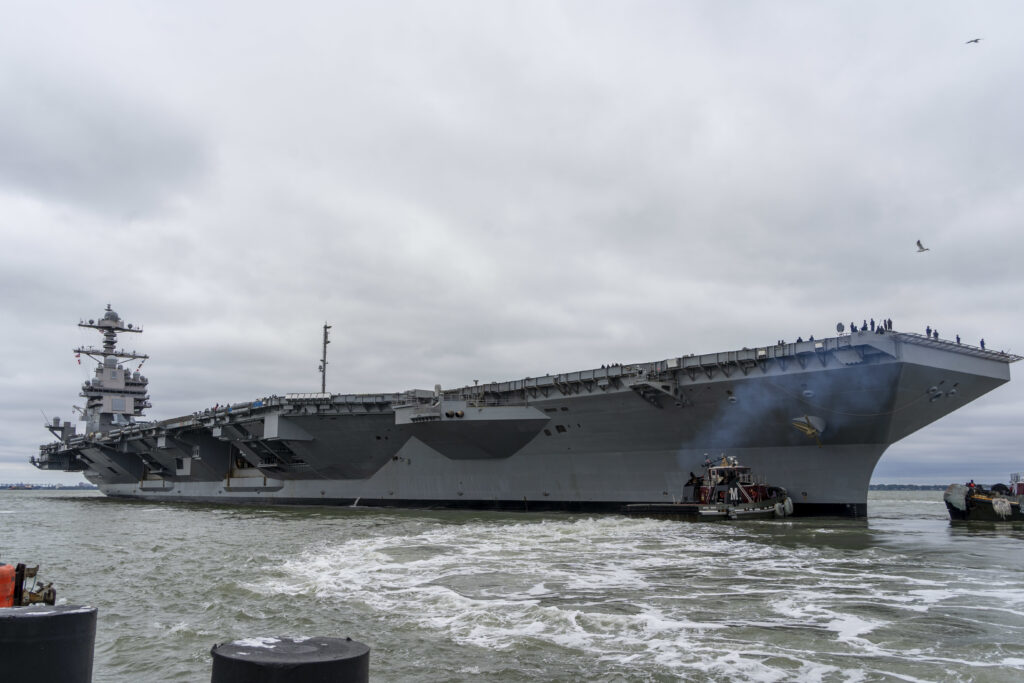
ARLINGTON, Va. — The lead ship U.S. Navy’s newest class of nuclear-powered aircraft carrier, USS Gerald Ford (CVN 78), delayed a day for weather, departed Naval Station Norfolk, Virginia, Oct. 4 on its first major deployment.
“This afternoon the Navy’s newest and most advanced aircraft carrier USS Gerald R. Ford (CVN 78) set out on deployment,” said Lt. Danielle Moser, deputy public affairs officer for Commander, U.S. 2nd Fleet, in an Oct. 4 release.
The Ford is making what the Navy calls a “service-retained” deployment, meaning it is operating by the authority of the chief of naval operations under command and control of the U.S. 2nd Fleet, rather than under the command and control of a regional combatant commander under the Global Force Management Concept.
Vice Adm. Daniel Dwyer, commander of the U.S. 2nd Fleet, said Carrier Strike Group 12 (CSG 12), of which the Ford is a part, will range throughout the Atlantic Ocean operating with navies of allied and partner nations.
Dwyer, speaking to reporters Sept. 26, said the deployment would provide the Ford CSG commander “a chance to test the carrier’s air operability prior to embarking on its first Global Force Management deployment next year. This historic service-retained deployment is an opportunity for the U.S. Navy to come together with other members of the NATO Alliance to exercise and train together within the Atlantic and its littorals while testing out advanced technologies on the first new class of U.S. aircraft carrier in more than 40 years.”
CSG-12 and Destroyer Squadron Two staffs will be embarked in the Ford, as will Carrier Air Wing Eight. Deploying with the group will be Ticonderoga-class guided-missile cruiser USS Normandy (CG 60); the Arleigh Burke-class guided-missile destroyers USS Ramage (DDG 61), USS McFaul (DDG 74), and USS Thomas Hudner (DDG 116); the Legend-class national security cutter USCGC Hamilton (WMSL 753); the Henry J. Kaiser-class fleet replenishment oiler USNS Joshua Humphpries (T-AO 188), and the Lewis and Clark-class dry cargo and ammunition ship USNS Robert E. Peary (T-AKE 5).
Units from eight allied and partner nations will operate with the CSG and include ships from Canada, Denmark, Finland, France, Germany, The Netherlands, Spain and Sweden. The CSG includes 17 ships and one submarine.
While deployed, the Ford CSG will conduct group steaming, air-defense exercises, maritime domain awareness, long-range maritime strike, distributed maritime operations, antisubmarine warfare exercises and naval integration, Dwyer said.
All eight squadrons of Carrier Air Wing Eight will be onboard for the deployment but some will not be at full strength in terms of numbers of aircraft.
“It won’t be the full complement, but it will be nearly the entire air wing,” Dwyer said. “And that is not because of any lack of capacity aboard Ford, but only where the air wing is in the Global Force Management process. We’re still sizing the numbers, but it will be a fairly full air wing, but not the complete air wing.”
New Technology
The Ford, commissioned in 2017, is deploying with 43 new technologies, including the Electro-Magnetic Aircraft Launch System, and the Advanced Arresting Gear.
The Ford’s commanding officer, Capt. Paul Lanzilotta, said in a Sept. 29 interview that all systems have been tested and are ready to go, and some will go through further operational testing.
Lanzilotta, a native of Long Island, New York, is an E-2 Hawkeye naval flight officer. He said the Ford has “incredible network connectivity.”
- BlueHalo to Test C-UAS System on Marine Corps JLTV - April 29, 2024
- USS George Washington Deploys to U.S. Southern Command, Eventually Headed to Japan - April 26, 2024
- SECNAV Advocates Increased Legal Immigration to Increase Shipbuilder Workforce - April 23, 2024



